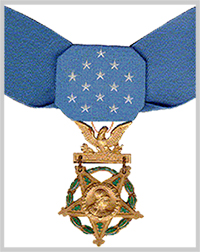
The Medal of Honor is the HIGHEST military decoration awarded by the United States government. It is bestowed by the President in the name of Congress, and is conferred only upon members of the United States Armed Forces who distinguish themselves through "conspicuous gallantry and intrepidity at the risk of his or her life above and beyond the call of duty while engaged in an action against an enemy of the United States." Due to the nature of its selection criteria, it is often awarded posthumously, with more than half of all awards since 1941 given to individuals who were deceased. As the award citation includes the phrase "in the name of Congress", it is sometimes erroneously called the "Congressional Medal of Honor". The official title, however, is simply the "Medal of Honor". Members of all branches of the armed forces are eligible to receive the medal, and there are three different versions (one for the Army, one for the Air Force, and one for the Navy, the Marine Corps, and the Coast Guard). The Medal of Honor is presented directly to the recipient (or for posthumous awards, to the next of kin) by the President of the United States on behalf of the US Congress, a procedure and ceremony intended to represent and recognize the gratitude not just of the American government, but of the American people as a whole. Due to its honored status, the medal is afforded special protection under U.S. law. The Medal of Honor is one of only two military neck order awards issued by the United States, and is the only neck order that is awarded to members of the United States Armed Forces. The Commander's Degree of the Legion of Merit is a neck order of the US, but it is only authorized for issue to foreign dignitaries.
The following information was taken from the Congressional Medal of Honor Society. Their website has a lot of interesting information about the society.
These are the man from the 11th Light Infantry Brigade - Vietnam, who were awarded the Medal of Honor.
RANK: STAFF SERGEANT (HIGHEST RANK: FIRST SERGEANT)
CONFLICT/ERA: VIETNAM WAR
UNIT/COMMAND: COMPANY B, 4TH BATTALION, 21ST INFANTRY, 11TH INFANTRY BRIGADE, AMERICAL DIVISION
MILITARY SERVICE BRANCH: U.S. ARMY
MEDAL OF HONOR ACTION DATE: AUGUST 26, 1968
MEDAL OF HONOR ACTION PLACE: WEST OF TAM KY, REPUBLIC OF VIETNAM
CITATION
For conspicuous gallantry and intrepidity in action at the risk of his life above and beyond the call of duty. S/Sgt. Bacon distinguished himself while serving as a squad leader with the 1st Platoon, Company B, during an operation west of Tam Ky. When Company B came under fire from an enemy bunker line to the front, S/Sgt. Bacon quickly organized his men and led them forward in an assault. He advanced on a hostile bunker and destroyed it with grenades. As he did so, several fellow soldiers, including the 1st Platoon leader, were struck by machine-gun fire and fell wounded in an exposed position forward of the rest of the platoon. S/Sgt. Bacon immediately assumed command of the platoon and assaulted the hostile gun position, finally killing the enemy gun crew in a singlehanded effort. When the 3d Platoon moved to S/Sgt. Bacon's location, its leader was also wounded. Without hesitation S/Sgt. Bacon took charge of the additional platoon and continued the fight. In the ensuing action he personally killed four more enemy soldiers and silenced an antitank weapon. Under his leadership and example, the members of both platoons accepted his authority without question. Continuing to ignore the intense hostile fire, he climbed up on the exposed deck of a tank and directed fire into the enemy position while several wounded men were evacuated. As a result of S/Sgt. Bacon's extraordinary efforts, his company was able to move forward, eliminate the enemy positions, and rescue the men trapped to the front. S/Sgt. Bacon's bravery at the risk of his life was in the highest traditions of the military service and reflects great credit upon himself, his unit, and the U.S. Army.
Accredited to: Phoenix, Maricopa County, Arizona
Awarded Posthumously: No
Presentation Date & Details: November 24, 1969 The White House, presented by Pres. Richard M. Nixon
Born: November 25, 1945, Caraway, Craighead County, AR, United States
Died: July 17, 2010, Rosebud, AR, United States
Buried: Arkansas State Veterans Cemetery, Little Rock, AR, United States
Location of Medal: MacArthur Museum of Arkansas Military History (duplicate Medal), Little Rock, AR
Rank: Sergeant
Conflict/Era: Vietnam War
Unit/Command: 1st Platoon, Company B, 1st Battalion, 20th Infantry, 11th Infantry Brigade, 23d Infantry Division (Americal)
Military Service Branch: U.S. Armybr> Medal of Honor Action Date: March 3, 1969
Medal of Honor Action Place: west of Landing Zone Liz, Republic of Vietnam
Citation
For conspicuous gallantry and intrepidity in action at the risk of his life above and beyond the call of duty. Sgt. Stone distinguished himself while serving as squad leader of the 1st Platoon. The 1st Platoon was on a combat patrol mission just west of Landing Zone Liz when it came under intense automatic-weapons and grenade fire from a well-concealed company-size force of North Vietnamese regulars. Observing the platoon machine gunner fall critically wounded, Sgt. Stone remained in the exposed area to provide cover fire for the wounded soldier who was being pulled to safety by another member of the platoon. With enemy fire impacting all around him, Sgt. Stone had a malfunction in the machine gun, preventing him from firing the weapon automatically. Displaying extraordinary courage under the most adverse conditions, Sgt. Stone repaired the weapon and continued to place on the enemy positions effective suppressive fire which enabled the rescue to be completed. In a desperate attempt to overrun his position, an enemy force left its cover and charged Sgt. Stone. Disregarding the danger involved, Sgt. Stone rose to his knees and began placing intense fire on the enemy at point-blank range, killing six of the enemy before falling mortally wounded. His actions of unsurpassed valor were a source of inspiration to his entire unit, and he was responsible for saving the lives of a number of his fellow soldiers. His actions were in keeping with the highest traditions of the military profession and reflect great credit on him, his unit, and the U.S. Army.
Accredited to: Syracuse, Onondaga County, New York
Awarded Posthumously: Yes
Presentation Date & Details: April 7, 1970 The White House, presented by Pres. Richard M. Nixon to his family
Born: June 4, 1947, Binghamton, Broome County, NY, United States
Died: March 3, 1969, Republic of Vietnam
Buried: Chenango Valley Cemetery (MH), Binghamton, NY, United States
Rank: Private First Class
Conflict/Era: Vietnam War
Unit/Command: Headquarters & Headquarters Company, 3d Battalion, 1st Infantry, 11th Infantry Brigade, Americal Division
Military Service Branch: U.S. Army
Medal of Honor Action Date: May 13, 1970
Medal of Honor Action Place: Republic of Vietnam
Citation
Pfc. Winder distinguished himself while serving in the Republic of Vietnam as a senior medical aidman with Company A. After moving through freshly cut rice paddies in search of a suspected company-size enemy force, the unit started a thorough search of the area. Suddenly they were engaged with intense automatic-weapons and rocket-propelled-grenade fire by a well-entrenched enemy force. Several friendly soldiers fell wounded in the initial contact and the unit was pinned down. Responding instantly to the cries of his wounded comrades, Pfc. Winder began maneuvering across approximately 100 meters of open, bullet-swept terrain toward the nearest casualty. Unarmed and crawling most of the distance, he was wounded by enemy fire before reaching his comrades. Despite his wounds and with great effort, Pfc. Winder reached the first casualty and administered medical aid. As he continued to crawl across the open terrain toward a second wounded soldier he was forced to stop when wounded a second time. Aroused by the cries of an injured comrade for aid, Pfc. Winder's great determination and sense of duty impelled him to move forward once again, despite his wounds, in a courageous attempt to reach and assist the injured man. After struggling to within 10 meters of the man, Pfc. Winder was mortally wounded. His dedication and sacrifice inspired his unit to initiate an aggressive counterassault which led to the defeat of the enemy. Pfc. Winder's conspicuous gallantry and intrepidity in action at the cost of his life were in keeping with the highest traditions of the military service and reflect great credit on him, his unit, and the U.S. Army.
Accredited to: Columbus, Franklin County, Ohio
Awarded Posthumously: Yes
Presentation Date & Details: July 17, 1974 Blair House (Courtyard), presented by Vice Pres. Gerald R. Ford to his family
Born: August 10, 1946, Edinboro, Erie County, PA, United States
Died: May 13, 1970, Republic of Vietnam
Buried: Mansfield Memorial Park (PMH) (B-465-4), Mansfield, OH, United States
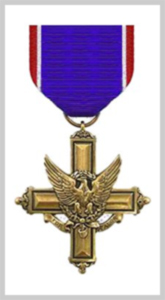
The Distinguished Service Cross (DSC) is the SECOND HIGHEST military decoration that can be awarded to a member of the United States Army (and previously, the United States Army Air Forces). It is awarded for extraordinary heroism:
Actions that merit the Distinguished Service Cross must be of such a high degree that they are above those required for all other U.S. combat decorations but do not merit award of the Medal of Honor. The Distinguished Service Cross is equivalent to the Navy Cross (Navy and Marine Corps, and Coast Guard when operating under the authority of the Department of the Navy) and the Air Force Cross (Air Force).
The Distinguished Service Cross is distinct from the Distinguished Service Medal, which is awarded to Army soldiers in recognition of exceptionally meritorious service to the government of the United States in a duty of great responsibility. The Distinguished Service Cross is only awarded for actions in combat, while the Distinguished Service Medal has no such restriction.
Information from Medals of America and Wikipedia.
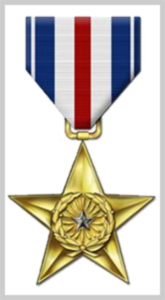
The Silver Star Medal is the United States' THIRD HIGHEST award exclusively for combat valor, and ranks fifth in the precedence of military awards behind the Medal of Honor, the Crosses (DSC/NC/AFC), the Defense Distinguished Service Medal (awarded by DOD), and the Distinguished Service Medals of the various branches of service. It is the highest award for combat valor that is NOT unique to any specific branch; it has been bestowed by the Army, Navy, Marine Corps, Air Force, Coast Guard, and Merchant Marines. It may be given by any one of the individual services to not only their own members, but to members of other branches of service, foreign allies, and even to civilians for "gallantry in action" in support of combat missions of the United States military.
The Silver Star may be awarded to any individual serving in any capacity with the U.S. Armed Forces who distinguishes himself or herself by gallantry in action under any of the following circumstances:
Because the Silver Star is ONLY awarded for combat valor, the only devices worn on it are:
(Seven Awards of the Silver Star then, would be displayed on the ribbon as a Silver OLC and 1 Bronze OLC for Army or Air Force. For Navy/Marine Corps Awards it would be a Silver Star plus 1 Gold Star.)
Information from Military Awards for Valor.
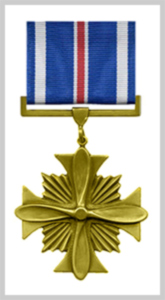
The Distinguished Flying Cross medal is the fourth-highest award for heroism and the highest award for extraordinary aerial achievement, not necessarily in a combat zone. The Distinguished Flying Cross medal is awarded to any officer or enlisted person of the armed forces of the United States for heroism or extraordinary achievement while participating in aerial flight. The heroism or achievement must be entirely distinctive, involving operations that are not routine. It is not awarded for sustained operational activities and flights. The DFC medal was established by an Act of Congress on July 2, 1926 and the first Distinguished Flying Cross citations were presented to the Pan American Good Will Flight pilots on 2 May 1927 by President Calvin Coolidge. President Coolidge also presented the first Distinguished Flying Cross medal, on 11 June 1927, to then Captain Charles A. Lindbergh of the Army Air Corps Reserve, for his solo flight of 33 ½ hours and 3600 statute miles.
Unlike the medals awarded, combat is not the only reason the Distinguished Flying Cross was created. It could be awarded for achievements in flight as well as bravery. The executive order of March 1927 ruled that the Distinguished Flying Cross should not be conferred on civilians. However, a number of civilian aviation pioneers have been awarded the DFC by Acts of Congress, including Wiley Post, Jacqueline Cochran, Roscoe Turner, Glenn H. Curtiss, and Eugene Ely. On February 23, 1929, Congress passed special legislation to allow the award of the DFC to the Wright brothers for their December 17, 1903, flight. Also, Amelia Earhart is one such Distinguished Flying Cross recipient who earned her medal through achievement rather than on the battlefield.
Information from The Distinguished Flying Cross Society, Military Benefits & Wikipedia.
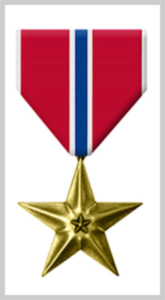
The Bronze Star Medal, or BSM, dates back to World War II. Today, it is the FOURTH HIGHEST ranking award a service member can receive for for either heroic achievement, heroic service, meritorious achievement, or meritorious service in a combat zone. For those who receive the BSM, it is a signal of their sacrifice, bravery and honor while serving their country.
The Bronze Star Medal may be awarded by the Secretary of a military department or the Secretary of Homeland Security to any person who, while serving in any capacity in or with the Army, Navy, Marine Corps, Air Force, Space Force, or Coast Guard of the United States, after 6 December 1941, distinguishes, or has distinguished, herself or himself by heroic or meritorious achievement or service, not involving participation in aerial flight—
The acts of heroism are of a lesser degree than required for the award of the Silver Star. The acts of merit or acts of valor must be less than that required for the Legion of Merit but must nevertheless have been meritorious and accomplished with distinction.
Civilians serving with U.S. military forces in combat are also eligible for the award. For example, UPI reporter Joe Galloway was awarded the Bronze Star with "V" device during the Vietnam War for rescuing a badly wounded soldier under fire in the Battle of Ia Drang, in 1965. Another civilian recipient was writer Ernest Hemingway.
Information from Wikipedia.
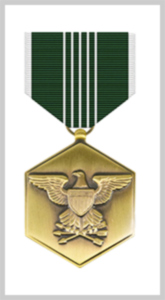
Army Commendation Medal, abbreviated and often called ‘ARCOM’, was instituted in 1945 and was awarded retroactively to those who served after December 6, 1941. The ARCOM is awarded to those who have served with the U.S. Army and have demonstrated heroism, meritorious achievement, or meritorious service. The Army Commendation Medal was one of the many military awards created right after World War II to decorate and honor the brave soldiers that served in one of the deadliest conflicts known to man. The Army Commendation Medal is often awarded if the actions of the recipient do not meet the requirements of the Soldiers Medal or the Bronze Star.
The award orginally started as a ribbon only, in 1949 it became a ribbon with pendant and in 1960 was completely redesigned to the medal we know today. And in 1962 the authorization for the medal changed to allow members of the Armed Forces of a friendly nation for the same level of achievement or service which was mutually beneficial to that nation and the United States. Now it is a highly regarded U.S. Army award.
The devices approved for the ARCOM are bronze and silver oak leaf clusters. Each oak leaf cluster denotes an additional award of the ARCOM. On February 29, 1964 the bronze "V" attachment was approved for the ARCOM. The bronze "V" device denotes acts of combat heroism that are to a lesser degree to be awarded the Bronze Star Medal.
Taken from Medals of America
The Combat Infantryman Badge (CIB) is an award of the United States Army which is presented to those officers, warrant officers and enlisted soldiers, in the grade of Colonel and below, who participate in active ground combat while assigned as a member of an infantry or Special Forces unit, brigade or smaller size, during any period subsequent to December 6, 1941. It was created with the primary goal of recognizing the sacrifices of the infantrymen who were disproportionately likely to be killed or wounded during World War II. The Combat Infantryman Badge (CIB) and the Expert Infantryman Badge (EIB) were established by Section I, War Department Circular 269, dated October 27, 1943:
The present war has demonstrated the importance of highly proficient, tough, hard and aggressive infantry, which can be obtained only by developing a high degree of individual all-around proficiency on the part of every infantryman. As a means of attaining the high standards desired and to foster esprit de corps in infantry units; the Expert Infantryman and the Combat Infantryman badges are established for infantry personnel. That circular also stated that, “only one of these badges will be worn at one time” and that “the Combat Infantryman Badge is the highest award.”
Award of the CIB was officially authorized by an executive order dated November 15, 1943. It was made retroactive to December 6, 1941. By Act of Congress approved on June 10, 1944, all soldiers, except officers, awarded the CIB were entitled to an additional $10 per month. Army regulations issued during World War II never prescribed a specific period of time an Infantryman had to serve in combat to be eligible for the CIB. In 1947, a policy was implemented that authorized the retroactive award of the Bronze Star to soldiers who had received the Combat Infantryman Badge during World War II. The basis for doing this was that the CIB was awarded only to soldiers who had borne combat duties befitting the Bronze Star Medal and also that both awards required a recommendation by the commander and a citation in orders. Work to establish the CIB was initiated by General Marshall, who had been prompted by Medal of Honor recipient Major Charles W. Davis’ observation to him that “it would be wonderful if someone could design a badge for every infantryman who faces the enemy every day and every night with so little recognition.” The following is a history of the CIB. The CIB was established by the War Department on 27 October 1943. Lieutenant General Lesley J. McNair, then the Army Ground Forces commanding general, was instrumental in its creation. He originally recommended that it be called the “fighter badge.” The CIB was designed to enhance morale and the prestige of the “Queen of Battle.” Then Secretary of War Henry Stinson said, “It is high time we recognize in a personal way the skill and heroism of the American infantry.”
A soldier must meet the following requirements to be awarded the Combat Infantryman Badge:
Campaign or battle credit alone is not sufficient for award of the CIB. A recipient must be personally present and under hostile fire while serving in an assigned infantry or Special Forces primary duty, in a unit actively engaged in ground combat with the enemy. The unit in question can be of any size smaller than brigade.
Of the hundreds of thousands of Infantrymen who have fought in World War II, Korea and Vietnam, only 325 have been awarded the third award of the Combat Infantryman's Badge, known as the Triple CIB. These men were honored with a display at the National Infantry Museum.
Taken from the original History of the Combat Infantryman’s Badge website and Wikipedia
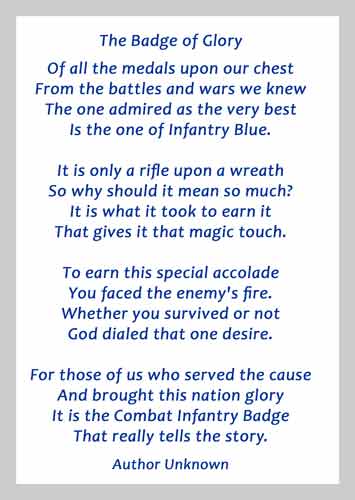
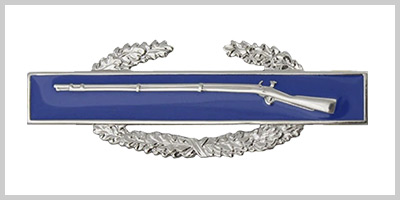
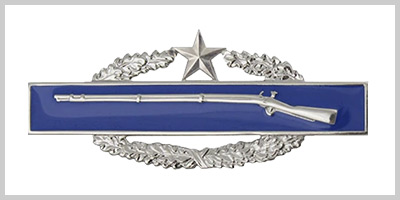
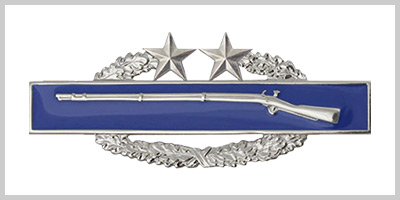
The Combat Medical Badge (CMB) is awarded to any member of the Army Medical Department, ranked Colonel or below, assigned to a medical unit providing support to an infantry or special forces unit during any period in which the unit was engaged in active ground combat. The CMB was first created in 1945, but is retroactive to December 6, 1941. The original decoration was considered a one-time decoration, however, this directive was rescinded in 1951. Multiple awards are denoted by stars encircling the decoration. According to the US Army Medical Department Regiment, to date there have been only two soldiers that have earned the Combat Medical Badge with two stars: Henry Jenkins and Wayne Slagel. The directive was again altered in 1969 to specify that only one award of the Combat Medical Badge is authorized for service in the Vietnam Conflict Era, which included service in Vietnam and Laos, the Dominican Republic, and South Korea (subsequent to 4 January 1969). Current regulations have expanded this qualifying period to include service in El Salvador, Grenada, Panama, Southwest Asia, and Somalia, and have added an additional qualifying period (the Global War on Terror Era) covering service in Iraq and Afghanistan.
In 1947, a policy authorized the retroactive award of the Bronze Star Medal to soldiers who had received the Combat Medical badge during the Second World War. The reasoning behind this was that the CMB was awarded only to soldiers who had borne combat duties befitting the Bronze Star Medal, also both awards required a citation in orders and a recommendation by the commander.
As of 2005 the rules for eligibility were changed to allow any medical department soldier in a brigade or lower unit to be eligible so long as they are engaged in actual ground combat and performed medical duties. This now includes Soldiers assigned to aviation units. Additionally, in 2008, IED/VBIEDs can now be considered direct contact with the enemy.
Information taken from Wikipedia and USAMM
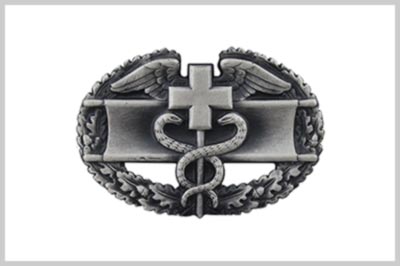
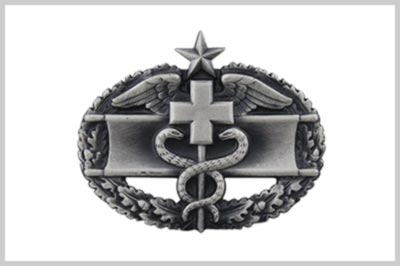
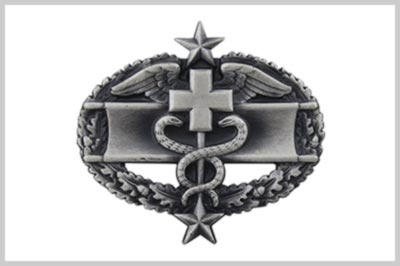
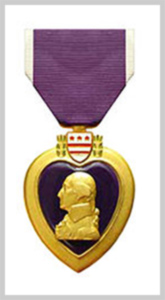
The Purple Heart is awarded in the name of the President of the United States to any member of the Armed Forces of the United States who, Purple Heart Awardwhile serving under competent authority in any capacity with one of the U.S. Armed Services after April 5, 1917, has been wounded or killed. Specific examples of services which warrant the Purple Heart include any action against an enemy of the United States; any action with an opposing armed force of a foreign country in which the Armed Forces of the United States are or have been engaged; while serving with friendly foreign forces engaged in an armed conflict against an opposing armed force in which the United States is not a belligerent party;
After 28 March 1973, as a result of an international terrorist attack against the United States or a foreign nation friendly to the United States, recognized as such an attack by the Secretary of the Army, or jointly by the Secretaries of the separate armed services concerned if persons from more than one service are wounded in the attack. After 28 March 1973, as a result of military operations while serving outside the territory of the United States as part of a peacekeeping force.
The Purple Heart differs from all other decorations in that an individual is not "recommended" for the decoration; rather he or she is entitled to it upon meeting specific criteria. A Purple Heart is awarded for the first wound suffered under conditions indicated above, but for each subsequent award an oak leaf cluster is worn in lieu of the medal. Not more than one award will be made for more than one wound or injury received at the same instant.
A "wound" is defined as an injury to any part of the body from an outside force or agent sustained under one or more of the conditions listed above. A physical lesion is not required; however, the wound for which the award is made must have required treatment by a medical officer and records of medical treatment for wounds or injuries received in action must have been made a matter of official record.
When contemplating an award of this decoration, the key issue that commanders must take into consideration is the degree to which the enemy caused the injury. The fact that the proposed recipient was participating in direct or indirect combat operations is a necessary prerequisite, but is not sole justification for award. The Purple Heart is not awarded for non-combat injuries. Enemy-related injuries which justify the award of the Purple Heart include injury caused by enemy bullet, shrapnel, or other projectile created by enemy action; injury caused by enemy placed land mine, naval mine, or trap; injury caused by enemy released chemical, biological, or nuclear agent; injury caused by vehicle or aircraft accident resulting from enemy fire; concussion injuries caused as a result of enemy generated explosions.
The Purple Heart Medal was originally last in precedence of all other personal decorations, but was elevated in 1985 by an act of Congress to a position just behind the Bronze Star.
The military medal is a heart-shaped, gold-rimmed medallion with a profile of George Washington on a purple enameled base. Above Washington’s profile is the shield from his family’s coat of arms. “FOR MILITARY MERIT” is inscribed on the reverse. The ribbon is a dark purple with narrow white edges. The original Badge of Military Merit was a satin purple heart edged in white. The format may have been used since the strongest wood available for gun carriages and weapons during the Revolution was called “Purpleheart”, a very strong smooth grain wood from Latin America that was stronger than the famous English oak. Here was an American wood that was stronger, more resistant to rot and termites than any other known wood. Perhaps General Washington chose the American Purpleheart wood as a symbol of strength and resistance over the British hearts of English Oak (a popular English military song of the time).Additional awards of the Purple Heart Medal are denoted by bronze and silver oak leaf clusters or gold and silver stars, depending on the recipient’s Service Branch.
Information from Wikipedia and Medals of America.

The National Defense Service Medal (NDSM) is a decoration presented to recognize all military members who have served in active duty during a declared "national emergency". To be eligible, members must have served honorably during one of the following time periods: The Korean War from June 27, 1950 - July 27, 1954; The Vietnam War from January 1, 1961 - August 14, 1974; The Gulf War from August 2, 1990 - November 30, 1995; the War on Terrorism from September 11, 2001 - a yet to be determined date. There is no requirement on the amount of time served within the time frames. Subsequent NDSM awards for active service in more than one of the eligible time periods are denoted by service stars worn on the original award ribbon.
Information from USAMM.

The Vietnam Service Medal (VSM) is a decoration of the U.S. military presented to personnel of any branch of the U.S. Armed Forces who performed military service during the Vietnam War and meet specific qualifications laid out by the United States Department of Defense. To be eligible service members must have completed 30 consecutive days or 60 non-consecutive days of service relating to direct support of ground operations or maritime service directly aiding military operations within specific regions of the Republic of Vietnam, Cambodia, Laos and Thailand between the dates of November 15, 1961 - March 28, 1973 and April 29, 1975 - April 30, 1975. U.S. Air Force members who flew in missions over Vietnam Airspace are also eligible for the award.
The Vietnam Service Medal replaces the Armed Forces Expeditionary Medal (AFEM), which was awarded for service in Vietnam from 1961 to 1965. Service stars are permitted as attachments worn on the Vietnam Service Medal for recipients who participated in multiple campaigns during the Vietnam War. The Arrowhead Device is permitted to be worn on the medal for those involved in an aerial or amphibious assault.
Information from USAMM.

The Republic of Vietnam Campaign Medal (VCM, VNCM) was a decoration presented by South Vietnam to recognize members of allied forces who served in the Vietnam War for a period of at least six months. Service members who were wounded, captured or killed in action were automatically awarded the medal regardless of time served. The "1960 Bar" device is given with the medal and was meant to indicate the years the war was fought from beginning to finish. Since the Republic of Vietnam was conquered by North Vietnam in 1975, the government no longer existed and no end date was ever made for the bar.
Information from USAMM.